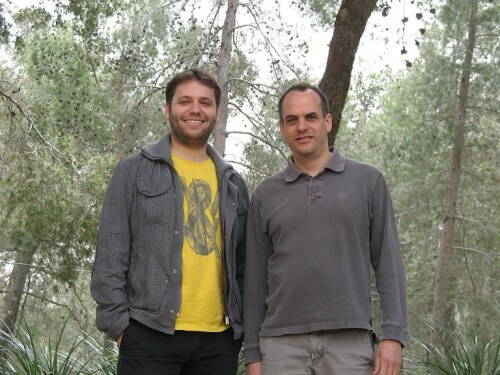The Wolf Foundation has announced the winners of the 2013 Kril Prize for Scientific Excellence. The prize, worth $10,000 each, will be distributed to ten scientists: three from the Weizmann Institute of Science, two from the Technion, and one from each of the following universities - Ben Gurion University, the Hebrew University of Jerusalem, Tel Aviv University, Bar Ilan University and Haifa University, including a scientist who cracked the autism genome; Scientist who developed the fastest camera in the world; A scientist who established the first laboratory in Israel to test gas and oil potential in the Mediterranean and more

The Wolf Foundation has announced the winners of the 2013 Kril Prize for Scientific Excellence. The prize, worth $10,000 each, will be distributed to ten scientists: three from the Weizmann Institute of Science, two from the Technion, and one from each of the following universities - Ben Gurion University, the Hebrew University of Jerusalem, Tel Aviv University, Bar Ilan University and Haifa University.
List of winners:
Dr. Shagib Shipman (42), The Hebrew University of Jerusalem: The genetics of autism - mapping a network of mutations linked to autism in genes according to their patterns of action in different areas of the human brain, and related to memory, learning and sensory information processing.
Dr. Kobi Gal (41). Ben Gurion University: Artificial intelligence and decision-making - development of computer software that enables the identification of a decision-making process in an environment that includes several people working on computers working together.
Dr. Nirit Dudovich (42), Weizmann Institute of Science: research of ultra-fast phenomena - the development of the world's fastest camera - photography technology using laser systems that "shoot" flashes of light at a speed of one billionth of a second, and manages to record the fastest natural phenomenon in the world - the movement of electrons in the atom
Dr. Anat Levin (34), Weizmann Institute of Science: Computational photography - development of a camera that makes it possible to produce sharp and clear images even in problematic physical conditions - vibrations, movement, lighting and too small a size. The technology that Dr. Levin is developing is a lens made up of many tiny segments with different focal lengths, which filters some of the light rays. These, along with a mathematical algorithm that she develops at the same time, produce sharp images even when the photo is taken without focus
Dr. Nicholas Waldman, University of Haifa: Reconstruction of climatic and environmental changes with the help of lake and marine sediments - conducting "geophysical surveys" (a kind of "ultrasound survey") of the seabed examining "sedimentary basins" - areas in the earth's crust filled with sediment or gas and drawing conclusions from this on geological changes that serve as a basis for reconstructing and predicting the climate in that region of the world
Dr. Yaakov Hana, (33) Weizmann Institute of Science: embryonic stem cells and epigenetic control - understanding the molecular basis of embryonic stem cells and reprogramming cells. This, through the genetic cloning technology, in which they take an egg, empty it of the genetic load it "brought from home", and plant a mature and sorted cell in it. Later, the egg becomes a "factory" where it produces a new and complete embryo, which is a genetic copy of the one that has the same depleted genetic cell. (An interview with Dr. Hana will be published tonight)
Prof. Itai Yanai (38), Technion: Evolution of developmental genetic pathways - the study of the genome, gene expressions, understanding their developmental pathway, and the evolution of genes that have undergone duplication in nematodes - this is in order to identify in the future changes in gene expression in humans according to the genome sequence, and thus identify and treat various genetic diseases
Dr. Tomer Volansky (38), Tel Aviv University: The problems of modern physics - high energy physics: particle theory, dark matter and cosmology.
Dr. Avinaam Zadok (40), Bar-Ilan University: Optical fibers and photonic devices - a combination of different materials in order to enable future computer communication. Use of optical fibers for early detection of failures and cracks in buildings and infrastructures.
Prof. Amit Knigal (41), Technion: Materials with strong electronic interactions - formulation of a new language for materials with strong electronic interactions, which will describe phenomena, such as conductivity and magnetism and other phenomena.
The prize will be awarded to the winners tomorrow, Wednesday, April 10 starting at 15:00 at a ceremony that will be held in Jerusalem.
The Wolf Foundation stated: "The ten winners were selected from about thirty outstanding candidates submitted from all academic institutions in Israel. The selected winners have proven and impressive excellence in the field of scientific research, which includes innovation and a creative and groundbreaking approach. With their joining the Krill winners from previous years, they constitute the future scientific infrastructure of the State of Israel."
The Krill Prize is a prize awarded in Israel, since 2005, by the Wolf Foundation for excellence in scientific research. The award, in the amount of $10,000, is intended for leading researchers who are outstanding academic faculty members, at the rank of lecturer or senior lecturer who have not yet received tenure, who are employed at one of the universities in Israel. Each year, the foundation awards six Creel awards in the following fields: exact sciences, life sciences, medicine, agriculture and engineering.
